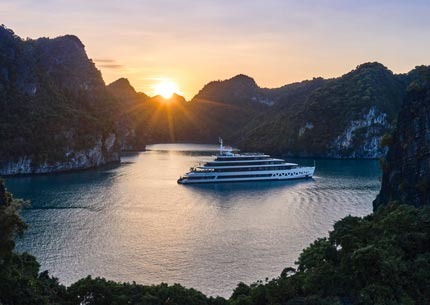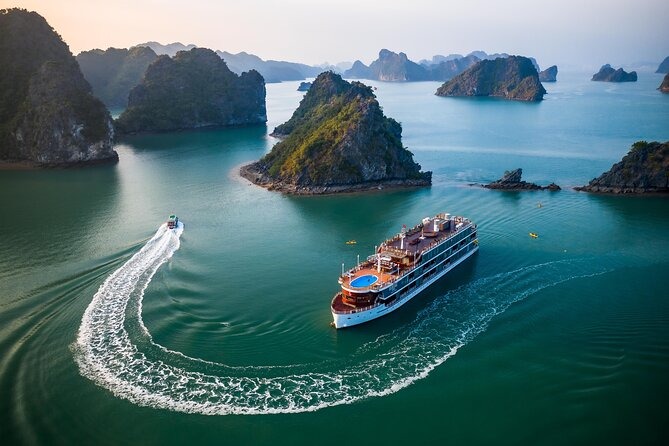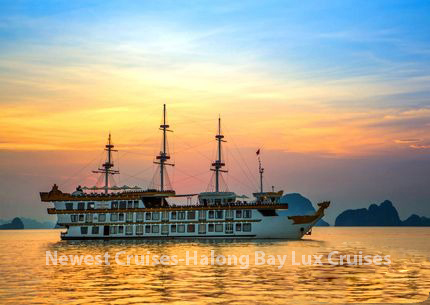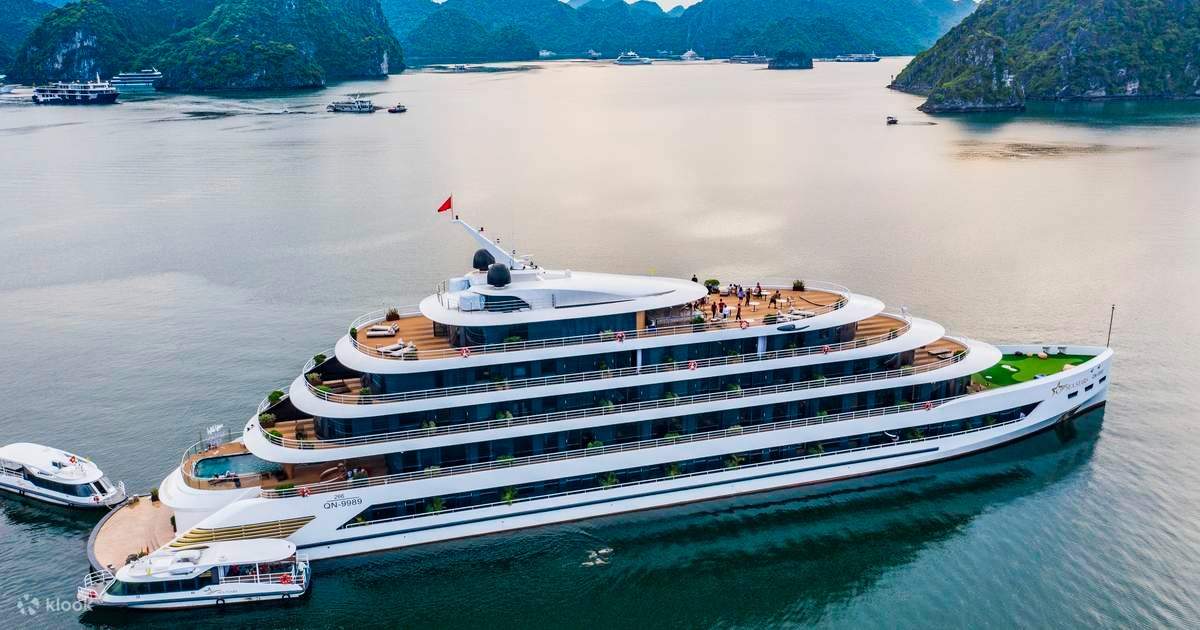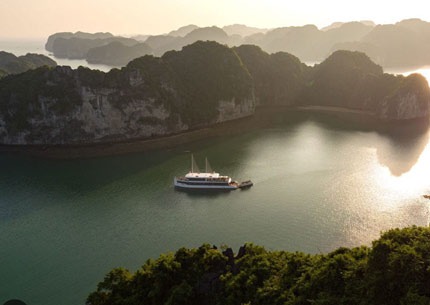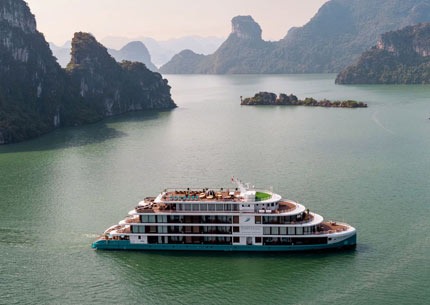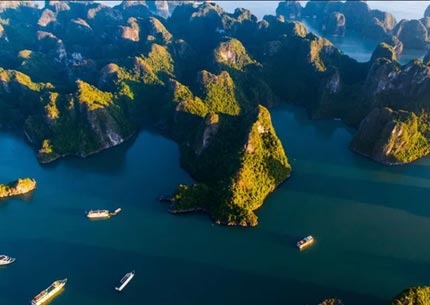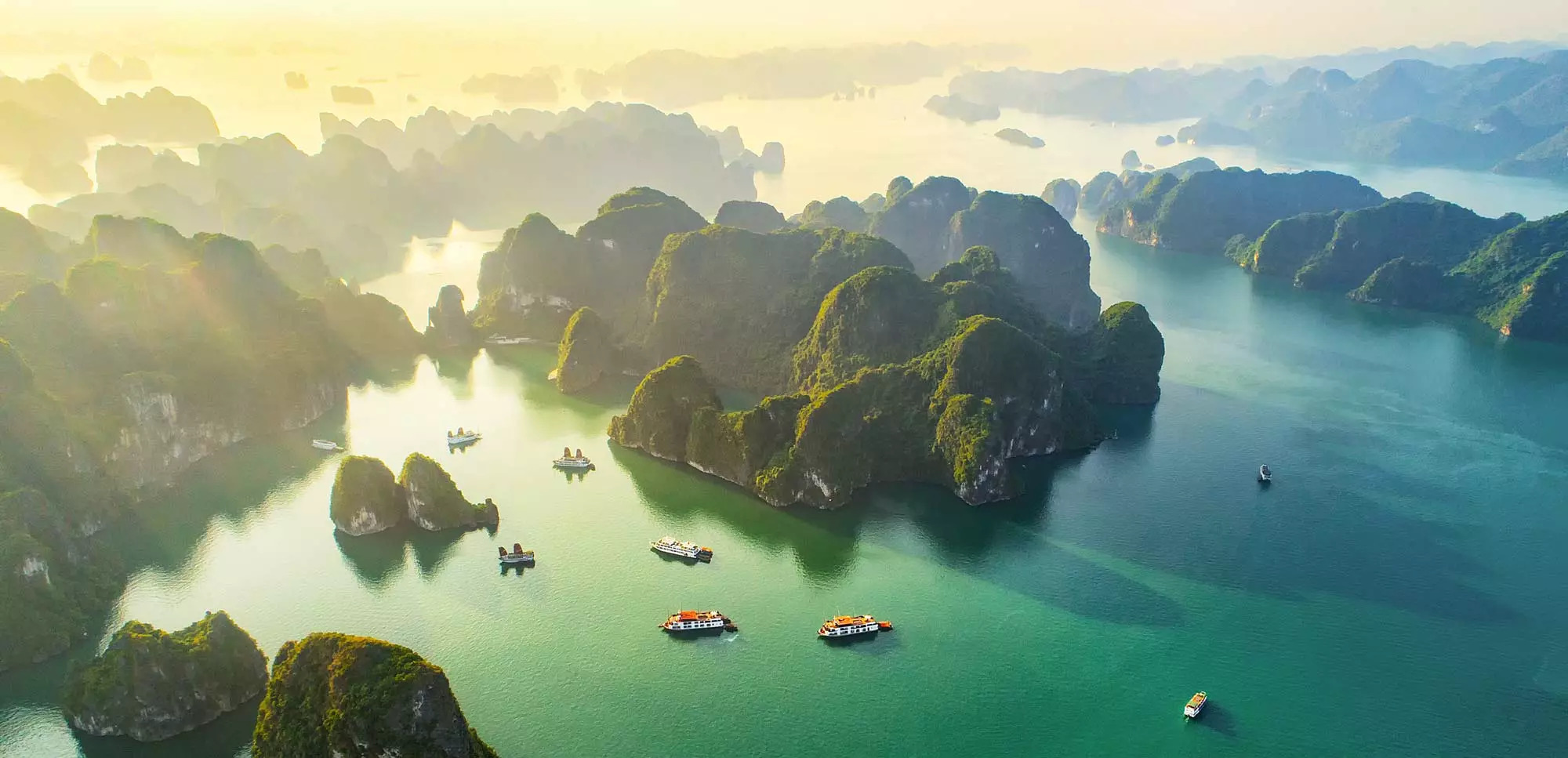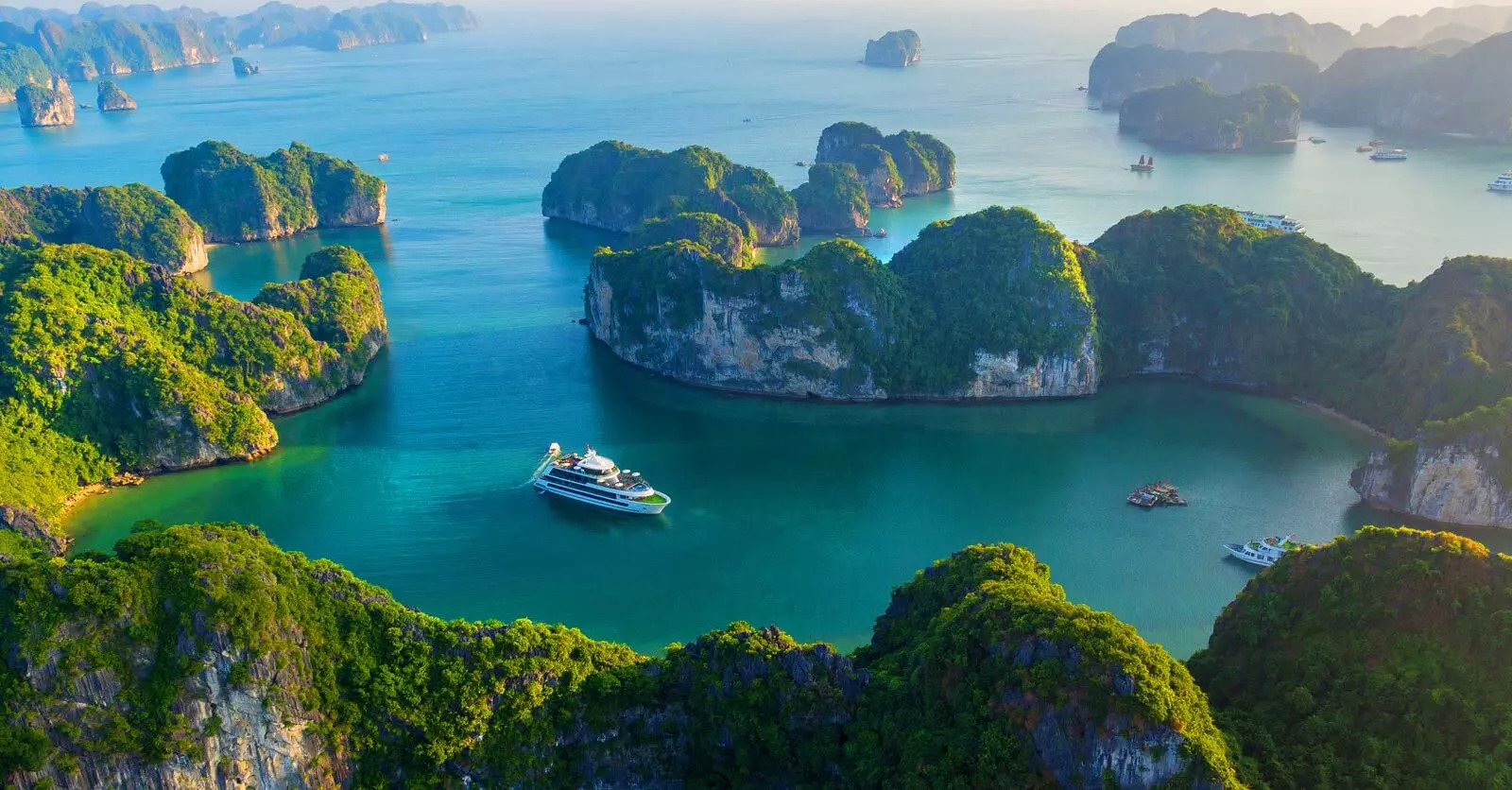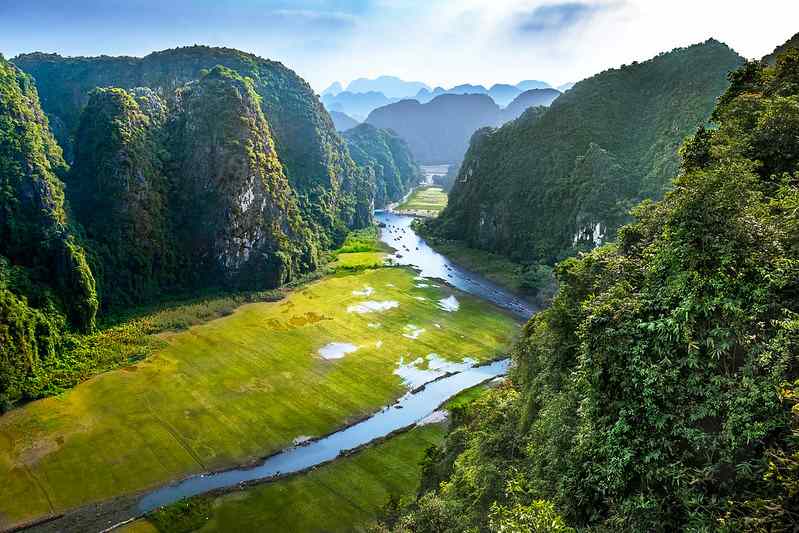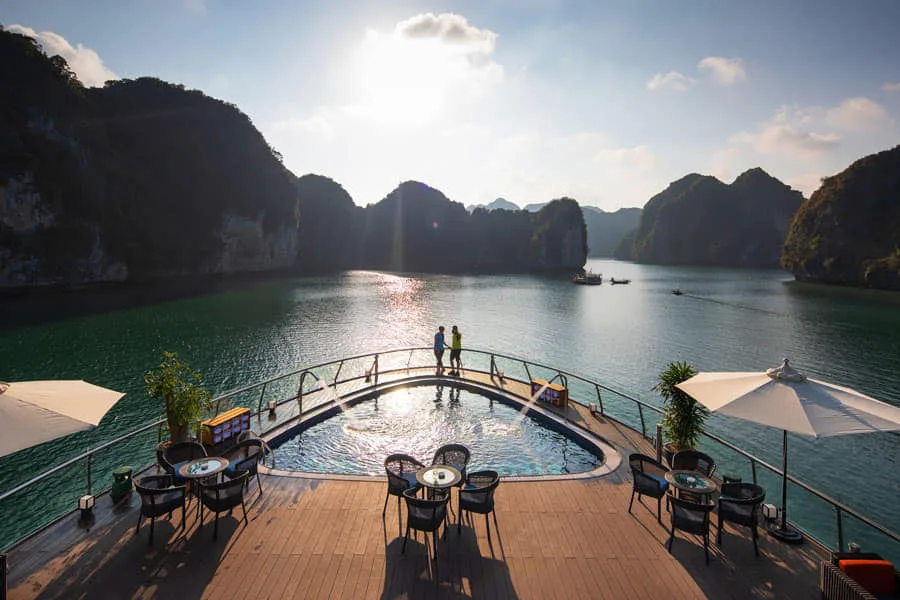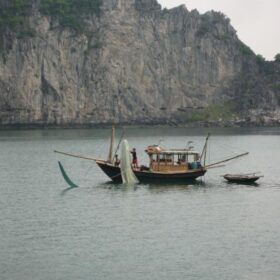24 Best Things to Do in Halong Bay During High Season (2025-2026 Ultimate Guide)
Discover the ultimate collection of Halong Bay experiences during its prime high season months. From luxury overnight cruises to secret cave explorations and authentic cultural immersions, this comprehensive 2025 guide reveals all the must-do activities, hidden gems, and expert tips to create your perfect Vietnam adventure in this UNESCO wonderland.
Halong Bay High Season: When Magic Happens on the Emerald Waters
Halong Bay transforms into a traveler’s paradise during its high season, which spans from October to April each year. This UNESCO World Heritage Site, featuring approximately 1,969 limestone islands and islets rising dramatically from emerald waters, offers its most visitor-friendly conditions during these months. The weather becomes pleasantly mild with temperatures ranging from 15-28°C, humidity levels drop significantly to 60-75% (compared to summer’s 85-90%), and rainfall decreases to less than 40mm per month on average.
The calm sea conditions during high season create perfect visibility for photography, with clear blue skies providing a stunning backdrop for the limestone karsts. Water clarity improves dramatically, making it ideal for swimming and underwater activities with visibility extending up to 8-10 meters in certain areas. This seasonal sweet spot balances comfortable conditions with natural beauty, explaining why over 70% of Halong Bay’s annual 7+ million visitors choose these months for their journey.
Let’s explore the absolute best experiences Halong Bay offers during this magical time of year.
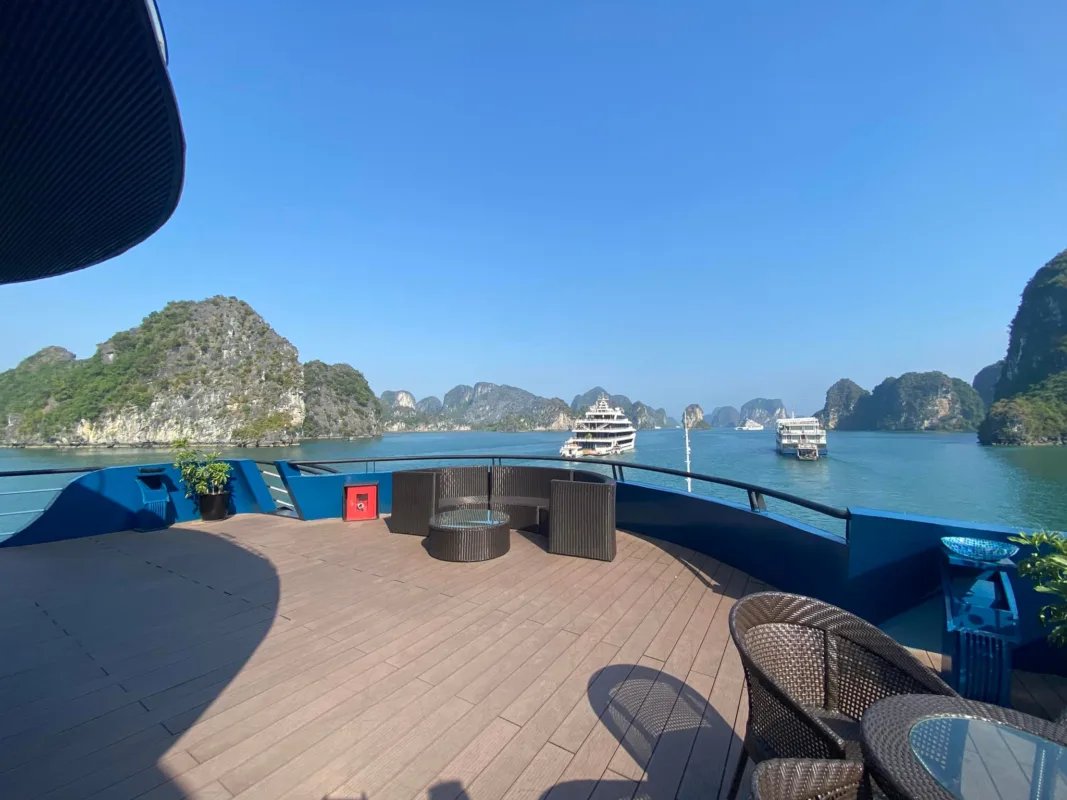
1. Embark on a Luxury Overnight Cruise Experience
Nothing captures the essence of Halong Bay better than sailing through its mystical waters on a luxury cruise. The 2025 season brings enhanced offerings from premium operators, with vessels featuring elegantly appointed cabins, private balconies, and world-class amenities.
Why Choose a Luxury Overnight Cruise
Halong Bay’s limestone formations reveal their full majesty when viewed from the water, and overnight cruises allow you to witness the bay’s transformation through different light conditions. At dawn, watch as the morning mist creates a dreamlike atmosphere around the karsts. By day, observe the vivid emerald waters contrasting with the lush vegetation. As dusk approaches, witness a spectacular sunset painting the limestone formations in golden hues.
Halong Bay Lux Cruises offers meticulously designed itineraries that balance relaxation with exploration. Their fleet features spacious 32-45m² cabins with floor-to-ceiling windows and private balconies measuring 4-6m², ensuring uninterrupted views of the bay’s natural wonders.
Ha Long Bay Lux Cruises – Best Price for Luxury Halong & Lan Ha Bay Cruises
🎨 2-Day Halong – Lan Ha Bay 5★ Cruise with Balcony Cabin
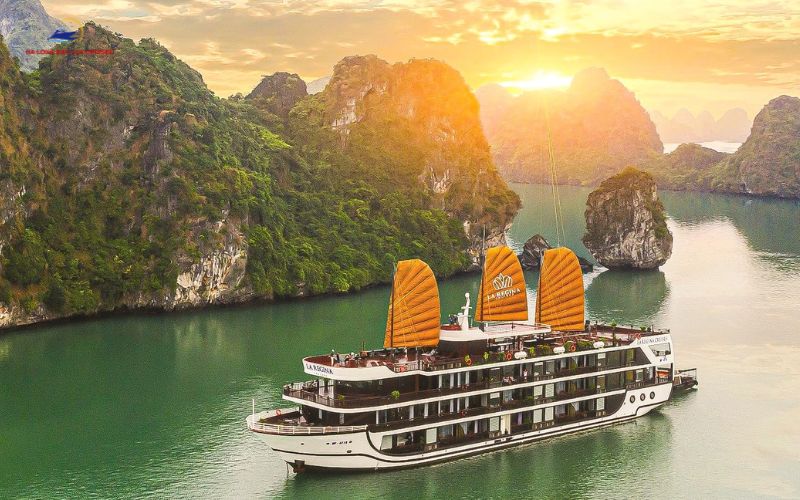
| 🚢 Cruise: | 2-Day Halong – Lan Ha Bay Lux Cruise |
| 🗺️ Itinerary: | Day 1: Hanoi Pickup → Tuan Chau Pier → Cruise Check-in → Bright & Dark Cave (Kayak/Bamboo Boat) → Sunset cocktail Day 2: Tai Chi → Cat Ba Island (Trung Trang Cave) → Check out → Return Hanoi |
| 💵 Price: | From $160/person (double occupancy) |
| 📍 Destinations: | Lan Ha Bay, Trung Trang Cave, Bright & Dark Cave, Cat Ba Archipelago |
| ⭐ Highlights: | 🎨 Boutique suites with Vietnamese design 🛶 Kayaking & rowing boat 🍷 Free Sunset Cocktail 🧘 Tai Chi session 📸 Sundeck & onboard gallery |
| 📋 Policies: | Free cancel up to 24h; child policy & single supplement apply |
| ✅ Includes: | Meals, guide, kayaking, Tai Chi, cooking class, tickets, insurance |
| 📞 Contact: | ☎️ +84 978 358 422 📧 halongbayluxcruises@gmail.com |
Best Cruise Itineraries for 2025-2026
For those with limited time, the 2-day Halong and Lan Ha Bay cruise offers a perfect introduction to the region’s highlights. You’ll visit key attractions like Sung Sot Cave and Ti Top Island while enjoying onboard amenities including Vietnamese cooking demonstrations and sunrise Tai Chi sessions.
For a more comprehensive experience, the 3-day luxury cruise through Lan Ha and Halong Bay ventures further into less-visited areas like Bright and Dark Cave, Cat Ba Island, and secluded beaches. The extended itinerary includes exclusive experiences such as private beach dinners and visits to authentic floating villages.
Expert Tip: Book your cruise at least 45-60 days in advance during high season, as premium cabins on top-rated vessels often sell out months ahead, especially for the December-January peak period.
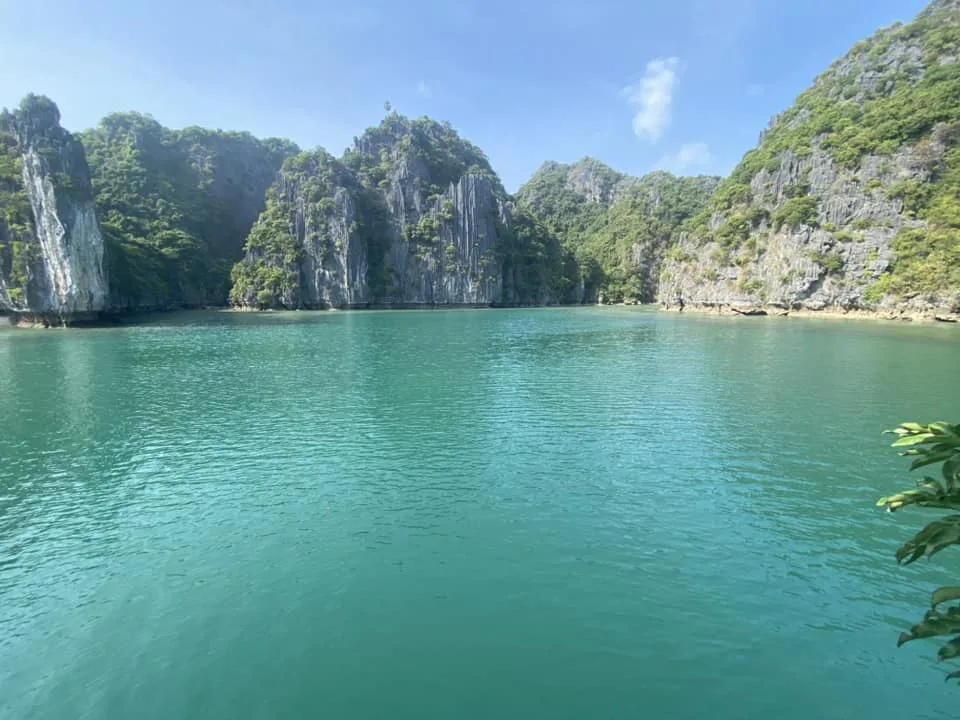
2. Explore the Magnificent Sung Sot Cave (Surprise Cave)
Sung Sot Cave stands as Halong Bay’s most impressive natural formation, spanning over 10,000 square meters across two massive chambers. Discovered by French explorers in 1901, this geological masterpiece captivates visitors with its extraordinary dimensions and otherworldly atmosphere.
Inside Halong Bay’s Largest Cave
The entrance to Sung Sot requires climbing approximately 50 stone steps, but the effort is immediately rewarded upon entering the first chamber. This vast 30-meter-high space features dramatically illuminated stalactites and stalagmites, with strategic lighting highlighting formations resembling sentinels standing guard.
The second chamber, even more spectacular, opens up to approximately 30 meters in height and 500 meters in length. Here, visitors encounter the “Royal Garden,” a serene area where a crystal-clear pond reflects the surrounding formations, and light filters through natural ceiling openings, creating ethereal light beams during midday visits.
Geological and Cultural Significance
Geologists estimate Sung Sot Cave formed over 500 million years ago, with each intricate formation developing at the painstakingly slow rate of approximately 1cm per century. Local guides share fascinating Vietnamese legends about the cave, including tales of dragons and ancient battles that supposedly shaped the unusual rock formations.
2025 Visitor Information: The cave now features an enhanced walkway system spanning 600 meters, with expanded viewing platforms at key points installed in late 2024. New sustainable LED lighting reduces environmental impact while improving visibility. For the best experience, visit between 9-10 AM when cruise traffic is lightest, allowing you to appreciate the majestic silence that gives the cave its atmospheric quality.
3. Kayak Through Hidden Lagoons and Secret Caves
Kayaking represents perhaps the most intimate way to experience Halong Bay’s wonders, allowing you to navigate through narrow passages inaccessible to larger vessels and discover secluded corners of this aquatic wonderland.
Top Kayaking Routes for 2025-2026
Luon Cave Circuit (60-90 minutes): Begin by paddling through the 100-meter limestone tunnel of Luon Cave, which opens into a spectacular enclosed lagoon surrounded by 100-meter karst walls. The calm, jade-green waters here are home to playful macaques that often gather along the rocky shores. Morning kayakers might spot eagles circling overhead, hunting for fish in the clear waters.
Three Peach Islets Area (Ba Trai Dao) (90-120 minutes): This route takes you around three distinctive islets that, according to local legend, represent three peaches brought by a heavenly fairy. The area features shallow waters with vibrant coral beds visible just below the surface. The route includes access to a hidden white-sand beach that’s only accessible during certain tide conditions, making it especially magical for those fortunate enough to time their visit right.
Cua Van Floating Village Circuit (120 minutes): Paddle through this authentic floating community where approximately 170 residents continue traditional fishing practices passed down through generations. The route offers cultural immersion alongside natural beauty, passing between floating homes where you’ll witness daily life unfolding on the water.
Kayaking Safety and Ecology Tips
High season brings ideal kayaking conditions with calm waters and excellent visibility. All reputable cruise operators provide modern sea kayaks (typically Ocean Kayak Malibu Two models) with comfortable backrests and safety equipment. Guides offer basic instruction before departure, making this activity accessible even for beginners.
Ecological Awareness: While paddling, maintain at least 20 meters distance from limestone formations to protect fragile ecosystems. Halong Bay’s 2025 conservation efforts emphasize “leave no trace” principles, as increasing visitor numbers have begun affecting the bay’s marine environment. Many operators now include brief ecological orientations highlighting how visitors can minimize their impact.
4. Summit Ti Top Island for Panoramic Bay Views
Ti Top Island stands as one of Halong Bay’s most recognizable landmarks, offering the perfect combination of active adventure and stunning vistas from its 110-meter summit. Named after Soviet cosmonaut Gherman Titov who visited with Ho Chi Minh in 1962, this small island (approximately 3.7 hectares) packs an outsized experience.
The Climb and the Reward
The journey to the Ti Top viewpoint involves ascending approximately 400 stone steps along a well-maintained path that winds upward through lush vegetation. The climbing difficulty is moderate, taking most visitors 15-20 minutes with rest stops. The path features several viewing platforms, allowing for phased appreciation of the increasingly spectacular scenery.
Upon reaching the summit, visitors are rewarded with what many consider Halong Bay’s most iconic 360-degree panorama. The viewing platform (expanded in 2024 to accommodate up to 100 people comfortably) provides unobstructed views across the bay, where countless limestone karsts stretch toward the horizon. On clear high-season days, visibility extends over 20km, revealing the full majesty of this UNESCO-protected seascape.
Ti Top’s Crescent Beach Experience
After descending, reward yourself at Ti Top’s crescent-shaped beach, spanning 400 meters of fine white sand. The beach area has been enhanced for 2025 with additional shade structures and improved changing facilities. The swimming area is clearly marked with safety buoys, creating a 2,000-square-meter protected zone with gentle slopes reaching depths of 2-3 meters.
Best Visit Timing: Arrive before 10 AM or after 3 PM to avoid peak crowds. The island hosts between 1,000-1,500 daily visitors during high season. For photographers, early morning visits offer dramatic lighting as the rising sun illuminates the bay’s karsts, while late afternoon visits capture the golden glow of sunset from the summit.
5. Experience Life in Cua Van Floating Village
Cua Van Floating Village provides a fascinating glimpse into a vanishing way of life, where residents have adapted to existence completely on water for generations. Recognized by Huffington Post as one of the world’s most beautiful floating villages, Cua Van is home to approximately 170 residents living in 40 floating homes anchored in a sheltered bay.
Cultural Immersion in Cua Van
Unlike some commercialized floating villages, Cua Van maintains authentic fishing traditions. Visitors can observe residents practicing traditional net fishing, shellfish cultivation, and boat building. The village functions as a complete community, with floating structures serving as homes, schools, and community gathering spaces.
The Cua Van Cultural Center, housed in a traditional floating structure, displays artifacts and photographs documenting centuries of floating life. Interactive exhibits demonstrate fishing techniques, boat construction methods, and the innovative adaptations villagers have developed for maritime living.
Sustainable Tourism Initiatives
Recent conservation efforts focus on preserving Cua Van’s cultural heritage while addressing environmental challenges. The 2025 Halong Bay Sustainable Floating Communities Initiative has implemented solar power systems for 75% of floating homes, reducing generator usage and minimizing water pollution.
Visitors can participate in cultural exchange programs, including:
- Traditional bamboo boat rowing lessons with village elders
- Pearl cultivation demonstrations (a primary village industry)
- Home-hosted meals featuring locally harvested seafood prepared using recipes passed through generations
A portion of all visitor fees directly supports the village preservation fund, helping maintain traditional structures and providing educational opportunities for village children.
6. Discover the Hidden World of Dark and Bright Cave
Dark and Bright Cave (Hang Sáng Tối) represents one of Halong Bay’s most magical geological wonders, yet remains less visited than more commercial sites. Located in Lan Ha Bay (technically an extension of Halong Bay), this extraordinary cave system offers a perfect blend of adventure and natural beauty.
Navigating Through Darkness into Light
The experience begins by kayaking or taking a bamboo boat through a 100-meter limestone tunnel—the “Dark Cave” portion. The passage narrows to just 4 meters wide in places, with a ceiling height of approximately 6 meters. This initial journey through darkness creates a theatrical element as visitors emerge into the spectacular “Bright Cave”—a completely enclosed lagoon spanning roughly 10,000 square meters.
The lagoon’s most striking feature is its perfect circular shape, resembling a natural amphitheater surrounded by limestone walls rising 100 meters vertically on all sides. The water depth varies between 2-4 meters depending on tides, with exceptional clarity allowing visibility to the lagoon floor in many areas.
Ecological Significance
The enclosed ecosystem harbors unique flora and fauna adapted to this sheltered environment. The waters contain distinctive fish species including the blue-spotted ribbontail ray and several varieties of rabbitfish. The surrounding walls support specialized vegetation that thrives in the microclimate created by the enclosed space.
In 2025, conservation authorities have implemented a visitor management system limiting simultaneous visitors to 60 people to protect the fragile ecosystem. The best viewing conditions occur between 11 AM and 2 PM, when sunlight penetrates through the natural ceiling openings, creating dramatic light beams that illuminate the emerald waters.
Insider Tip: Select the 3-day luxury cruise itinerary to visit this remarkable location, as shorter cruises typically don’t venture this far into Lan Ha Bay.
7. Indulge in a Floating Dinner Under the Stars
Halong Bay’s luxury cruise operators have elevated the concept of destination dining to new heights with exclusive floating dinner experiences. These magical evenings combine gourmet cuisine, atmospheric settings, and the incomparable backdrop of Halong’s limestone formations under starlit skies.
Elevated Culinary Experiences on the Water
The floating dinner concept varies among operators, but typically involves either:
- Private Floating Platforms: Diners are transported via tender to stationary floating restaurants measuring approximately 200-300 square meters, anchored in secluded bays. These platforms feature elegant dining setups illuminated by hundreds of lanterns and candles.
- Beach Dinner Experiences: On select uninhabited islets, cruise staff transform pristine beaches into romantic dining venues, with tables positioned at the water’s edge and tiki torches creating a magical atmosphere.
- Exclusive Onboard Experiences: Some luxury vessels create dedicated dining spaces on upper decks or transformed pool areas specifically for starlight dining.
Culinary Highlights for 2025-2026
The menus showcase the finest Vietnamese and fusion cuisine, with emphasis on ultra-fresh seafood harvested daily from the waters of Halong Bay. Signature dishes include:
- Halong Bay rock lobster steamed with lemongrass and served with lime-chili dipping sauce
- King prawns grilled tableside on volcanic hot stones
- Traditional Vietnamese clay pot fish featuring local sea bass in caramel sauce
- Bao quac (geoduck clam) prepared with garlic, chili and Vietnamese herbs
Many operators now offer wine pairings featuring both international selections and emerging Vietnamese vineyards like Dalat and Aythaya.
Romance Enhancement: For special celebrations, premium cruise lines offer customizable packages including dedicated staff, personalized menus, professional photography, and unique touches like message-in-a-bottle proposals or private musical performances.
8. Soar Above Halong Bay in a Seaplane
For a truly extraordinary perspective on Halong Bay’s vast limestone landscape, nothing compares to viewing it from above. Seaplane tours provide a breathtaking aerial overview impossible to appreciate from water level, revealing the true scale and patterns of this natural wonder.
The Ultimate Aerial Adventure
Hai Au Aviation continues to be the premier seaplane operator in 2025, utilizing a fleet of modern Cessna Grand Caravan EX aircraft. These planes accommodate 12 passengers in comfortable cabin-class seating, with each seat positioned next to a window for unobstructed viewing and photography.
Flight options include:
- 25-minute scenic flights covering the core Halong Bay area (approximately 30 kilometers of flyover)
- 40-minute extended routes encompassing Halong, Bai Tu Long Bay, and Lan Ha Bay (approximately 50 kilometers)
- Combination packages incorporating water landings and resort transfers
The seaplanes depart from Tuan Chau Marina, the main gateway to Halong Bay, with multiple daily flights scheduled during high season. Take-off and landing occur on water, adding another dimension of excitement to the experience.
Photography and Viewing Highlights
From cruising altitudes of 150-300 meters, passengers gain an unparalleled appreciation for Halong Bay’s scale and patterns. The aerial perspective reveals:
- The distinctive limestone formations clustering in geological families
- Hidden lagoons and cave systems invisible from water level
- The remarkable gradient of water colors ranging from deep blue to turquoise and emerald
- The dramatic shadow patterns cast by karsts during morning and late afternoon flights
2025 Enhancement: New routes have been developed focusing on photography opportunities, with flight paths timed to optimize lighting conditions. Morning flights (between 9-11 AM) generally offer the clearest visibility after overnight moisture has dissipated but before afternoon haze develops.
9. Trek Through Cat Ba National Park’s Ancient Rainforest
Cat Ba Island, the largest island in Halong Bay at 140 square kilometers, hosts a magnificent national park that provides a perfect terrestrial complement to the bay’s marine wonders. Cat Ba National Park encompasses 263 square kilometers of diverse ecosystems, including primary rainforest estimated to be over 3,000 years old.
Biodiversity and Ecological Significance
The park represents one of Vietnam’s most important biodiversity hotspots, home to 1,561 plant species (including 118 medicinal plants) and 282 animal species. Most notably, it shelters the critically endangered Cat Ba langur (golden-headed langur), one of the world’s rarest primates with a population of only 60-70 individuals remaining in the wild.
The park’s ecological zones range from coastal mangrove forests through limestone karst ecosystems to tropical rainforest, all accessible via well-maintained hiking trails. The dramatic limestone landscape features countless caves, hidden valleys, and spectacular viewpoints overlooking both forest and sea.
Premier Hiking Trails for 2025-2026
Kim Giao Forest Trail (4.5km, moderate difficulty): This newly enhanced trail winds through ancient forest featuring rare Kim Giao trees, prized for centuries for their unique wood grain. The 2-3 hour circuit includes stops at freshwater springs and limestone formations with informative signage about the forest’s medicinal plants.
Ngu Lam Peak Trail (6km, challenging): This trail ascends to a 225-meter summit offering spectacular 360-degree views across the island and surrounding bay. The challenging route requires approximately 3-4 hours round-trip, traversing diverse ecological zones with opportunities to spot wildlife including macaques, civets, and numerous bird species.
Frog Pond Loop (3km, easy): Perfect for families and casual hikers, this gentle trail circles a picturesque freshwater wetland habitat supporting numerous amphibian species. The 1.5-hour walk includes several observation platforms for wildlife viewing.
Conservation Note: Cat Ba National Park implemented enhanced conservation measures for 2025, including controlled access permits (maximum 200 daily visitors), guided-only zones for sensitive habitats, and expanded ranger patrols to protect endangered species. Visitors contribute directly to conservation efforts through park fees.
10. Master Vietnamese Cuisine in an Onboard Cooking Class
Immerse yourself in Vietnam’s celebrated culinary traditions through hands-on cooking classes offered aboard luxury Halong Bay cruises. These interactive experiences combine cultural education with gastronomic delight, allowing you to bring home authentic recipes and techniques as a lasting souvenir.
From Market to Table: The Complete Culinary Journey
The most comprehensive cooking programs begin before you even board your cruise. Select operators offer optional morning visits to local markets in Hai Phong or Halong City, where chef-guides demonstrate how to select the freshest ingredients and explain the distinctive herbs and spices that define Vietnamese cuisine.
Onboard classes typically run 60-90 minutes and are conducted in specially designed culinary studios featuring individual cooking stations. Each participant receives professional tools, ingredients, and step-by-step instruction from English-speaking chefs trained in both traditional techniques and effective teaching methods.
Signature Dishes and Techniques Taught
Most classes focus on 2-3 iconic Vietnamese dishes that showcase fundamental techniques and flavors. Popular options include:
- Nem Ran/Cha Gio (Vietnamese Spring Rolls): Master the art of rice paper wrapping, creating balanced fillings, and achieving the perfect crispy texture through proper frying techniques.
- Pho Cuon (Fresh Rice Noodle Rolls): Learn to handle delicate rice noodle sheets, prepare aromatic herb fillings, and create accompanying dipping sauces balancing sweet, sour, salty and spicy elements.
- Bun Cha (Grilled Pork with Rice Noodles): Discover traditional marinades, grilling methods, and the preparation of the distinctive dipping sauce featuring fish sauce, lime, chili, and pickled vegetables.
- Seafood Specialties: Many classes incorporate locally harvested seafood from Halong Bay waters, teaching techniques for preparing clams, prawns, and fish using traditional Vietnamese methods.
Cultural Immersion Element: Beyond cooking techniques, instructors share insights into the cultural significance of different dishes, regional variations throughout Vietnam, and the philosophy of balanced flavors that underlies Vietnamese cuisine. The experience culminates in enjoying your freshly prepared dishes, often accompanied by wine pairings or traditional Vietnamese rice wine.
11. Practice Sunrise Tai Chi on Deck
Begin your day in perfect harmony with Halong Bay’s serene landscape through morning Tai Chi sessions conducted on the open decks of luxury cruise vessels. This ancient Chinese practice combining flowing movements, controlled breathing, and mindfulness creates a magical experience when performed amid the misty limestone formations at dawn.
The Perfect Setting for Moving Meditation
Tai Chi sessions typically begin between 6:00-6:30 AM, precisely timed to coincide with the first light illuminating Halong Bay. The experience is conducted on the top deck of cruise vessels, providing 360-degree views of the awakening seascape. Many luxury operators have created dedicated spaces spanning 50-70 square meters specifically designed for morning wellness activities.
As participants move through gentle sequences, they witness the transformation of the bay—mist rising from the water, limestone karsts gradually revealed in the strengthening light, and the water’s surface shifting from silver to emerald as the sun rises. The natural soundtrack of gentle waves and distant birdsong enhances the meditative quality.
Instruction and Accessibility
Classes are led by certified instructors who have adapted traditional Tai Chi forms specifically for cruise guests of all experience levels. Sessions typically last 30-45 minutes and focus on accessible movements from the Yang style, the most widely practiced Tai Chi form known for its gentle, flowing sequences.
Instructors provide clear guidance in English, emphasizing proper alignment, breathing techniques, and the mindfulness aspects of the practice. No prior experience or special clothing is required, making this activity accessible to virtually all guests regardless of fitness level or age.
Wellness Integration: Premium cruise lines have expanded these sessions into comprehensive morning wellness rituals for 2025. The Tai Chi practice may be followed by a light detox tea service featuring ginger, lemongrass and local herbs, or optional meditation guidance focusing on connection with the natural surroundings.
12. Explore the Less-Visited Bai Tu Long Bay
While Halong Bay draws the majority of visitors, its northeastern neighbor Bai Tu Long Bay offers equally spectacular scenery with significantly fewer crowds. This 158-square-kilometer area contains hundreds of limestone islands and islets in arrangements some geologists consider even more dramatic than the main bay.
The Untouched Alternative to Halong Bay
Bai Tu Long shares the same geological origins as Halong Bay but receives only about 20% of the visitor traffic. The reduced boat presence creates a noticeably more tranquil atmosphere, with many areas feeling genuinely secluded. Water clarity often exceeds that of the main bay, with visibility reaching 4-5 meters in optimal conditions during high season.
Key features that distinguish Bai Tu Long include:
- Taller, more dramatic limestone formations, with many karsts exceeding 100 meters in height
- Higher concentration of beaches, with over 40 accessible white sand coves
- Richer marine biodiversity due to lower boat traffic and pollution levels
- Authentic fishing communities less impacted by tourism
Must-Visit Highlights in Bai Tu Long
Vung Vieng Fishing Village: Unlike more commercialized floating villages, Vung Vieng maintains traditional fishing practices and architecture. Approximately 50 households continue the centuries-old lifestyle, welcoming visitors to observe their pearl cultivation, net fishing, and boat building techniques.
Thien Canh Son Cave: This moderately sized cave (approximately 1,000 square meters) features exceptional stalactite and stalagmite formations with natural coloration ranging from amber to silver. The cave’s unique acoustics create remarkable sound effects as droplets fall from the ceiling.
Ban Chan Beach: This 700-meter crescent of white sand sits in the shelter of dramatic limestone cliffs. The protected position creates exceptionally calm swimming conditions even during winter months when other beaches may experience choppier waters.
Conservation Status: Bai Tu Long was designated a national park in 2001, receiving UNESCO recognition as part of the extended Halong Bay World Heritage area. The 2025 management plan has implemented a daily visitor quota system (maximum 2,000 daily visitors compared to Halong’s 12,000+) to preserve its pristine condition.
Access Note: The 3-day luxury cruise itinerary from Halong Bay Lux Cruises typically includes Bai Tu Long Bay in its extended routing, offering one of the most comfortable ways to access this less-visited region.
13. Try Traditional Night Squid Fishing
Experience a centuries-old fishing tradition that continues to thrive in Halong Bay waters with an evening squid fishing excursion. This hands-on activity combines cultural immersion with the excitement of catching your own dinner under the stars.
Ancient Techniques Under Modern Skies
Squid fishing in Halong Bay follows methods virtually unchanged for generations. The activity takes place between 8:00-10:00 PM when squid are naturally most active. The technique capitalizes on squids’ attraction to light—bright lamps positioned over the water draw them to the surface where they can be caught using simple handlines.
Cruise vessels typically designate a specific area for the activity, usually on lower decks close to the water. Specialized squid fishing rods (approximately 1.5 meters long) feature no reels but instead use a simple hand-over-hand retrieval method. The lures, traditionally carved from wood but now often plastic, use no bait but rely solely on movement to attract the squid.
The Complete Experience
The session begins with demonstration and instruction from crew members who often come from fishing families themselves. They demonstrate proper jigging techniques—the distinctive up-and-down rod movement that mimics injured fish and triggers the squid’s predatory response.
Participants then try their hand at the technique, often competing good-naturedly for the first or largest catch. When a squid is hooked, it typically releases its ink defense mechanism, creating excitement (and occasionally some mess) during retrieval. Caught squid are collected in illuminated water tanks where guests can observe these fascinating creatures up close.
Culinary Connection: Many cruises complete the experience by having the onboard chefs prepare the freshly caught squid as a late-night snack or addition to the next day’s lunch. Common preparations include:
- Flash-fried salt and pepper squid with chili
- Traditional Vietnamese squid salad with green mango
- Grilled squid with lime and Vietnamese herbs
Conservation Note: The activity follows sustainable fishing practices with strict catch limits and operates in designated areas to minimize ecosystem impact.
14. Witness Cave Dinner Shows in Surprise Cave
For a truly spectacular dining experience that blends natural wonder with cultural performance, the cave dinner shows inside Surprise Cave (Sung Sot) stand apart as Halong Bay’s most unique evening entertainment option. This exclusive experience is typically available only to guests on premium cruise itineraries, with limited availability requiring advance booking.
Dining in Nature’s Cathedral
These special events utilize a secluded chamber within Surprise Cave, separate from the main tourist route. The dining area occupies approximately 500 square meters of level cave floor, accommodated with elegant temporary furnishings that are completely removed after each event to protect the cave environment.
The natural acoustics of the cave enhance the dining atmosphere, with limestone formations creating remarkable sound qualities. The cave’s interior is illuminated using state-of-the-art LED systems that highlight key geological features while creating a magical ambiance. Temperature inside remains a consistent 22-25°C year-round, providing comfortable dining conditions regardless of outside weather.
Cultural Performance Elements
The dinner experience incorporates traditional Vietnamese performing arts adapted specifically for the cave setting:
- Water puppet performances: Miniature stages are created using portable pools where skilled puppeteers present abbreviated versions of classic water puppet stories.
- Traditional music ensembles: Musicians perform on instruments including the đàn bầu (monochord), đàn tranh (16-string zither), and t’rưng (bamboo xylophone), carefully selected to complement the cave acoustics.
- Đàn ca tài tử: This UNESCO-recognized southern Vietnamese musical tradition features improvised performances that interact with the cave’s natural sounds.
- Ethnic minority dances: Performers from Vietnam’s diverse ethnic groups present traditional dances adapted to utilize the dramatic shadows and lighting effects possible within the cave setting.
Environmental Considerations: These events operate under strict guidelines established by UNESCO and Vietnam’s heritage authorities. All equipment, furnishings, and materials are transported in and out for each performance, with zero-impact protocols protecting the sensitive cave environment. Visitor numbers are limited to 40-60 participants per event to minimize environmental impact.
15. Snorkel Among Vibrant Coral Reefs
While Halong Bay is primarily celebrated for its limestone landscapes, its underwater environment offers equally compelling attractions. The bay’s ecosystem includes extensive coral formations supporting diverse marine life, particularly in the less-visited southern and eastern regions.
Prime Snorkeling Locations for 2025-2026
Cong Do Area: Located in Bai Tu Long Bay, this protected marine reserve spans approximately 2 square kilometers and features shallow coral gardens at depths of 2-5 meters. The area is home to over 100 coral species, predominantly table corals, staghorn corals, and massive brain corals some reaching diameters of 2 meters.
Ba Trai Dao (Three Peach Islands): The sheltered coves between these distinctive islands harbor fringing reefs with exceptional biodiversity. Water clarity here reaches up to 8 meters during high season, with visibility best during morning hours before daily winds develop.
Van Gio Reef: This relatively newly promoted snorkeling site opened to visitors in 2024 features unique coral formations growing directly on vertical limestone walls, creating dramatic underwater landscapes. The site supports abundant reef fish including clownfish, butterflyfish, and occasional sightings of blacktip reef sharks (approximately 1 meter in length and harmless to humans).
Marine Life Encounters
Halong Bay’s protected waters support a surprising variety of marine species. Snorkelers commonly encounter:
- Diverse reef fish: Including damselfish, parrotfish, triggerfish, and pufferfish
- Invertebrates: Sea stars, giant clams (some specimens reaching 1 meter across), nudibranchs, and colorful Christmas tree worms
- Occasional pelagic visitors: During high season, snorkelers might spot sea turtles (primarily hawksbill and green varieties) and schools of squid
- Benthic creatures: Stingrays, flounder, and the unusual walking fish that uses modified fins to “walk” across the seabed
Conservation Awareness: Halong Bay’s marine protected areas operate under increasingly strict conservation guidelines for 2025. Visitors receive briefings on responsible snorkeling practices, including maintaining minimum distances from coral (3 meters), prohibition of touching marine life, and use of mineral-based sunscreens only. Some operators now include citizen science components, where guests can contribute to reef monitoring programs through simple observation tasks.
16. Capture the Perfect Photograph at Sunset
Halong Bay’s extraordinary landscape offers photographers endless possibilities, but the magical quality of light during sunset transforms the scenery into truly exceptional photographic opportunities. Understanding the best locations and techniques will help visitors capture frame-worthy images.
Prime Sunset Photography Locations
Titov Island Summit: The elevated viewpoint at 110 meters provides expansive western views where the setting sun creates dramatic silhouettes of the limestone karsts. The vantage point allows photographers to capture both the bay’s vast scale and the intricate details of individual formations.
Bai Tho Mountain (Poem Mountain): Located on the mainland in Halong City, this 200-meter peak offers a different perspective with the entire bay spread before you. The urban foreground creates interesting compositional contrasts with the natural seascape. Access requires a moderately challenging 30-minute hike.
Cua Van Floating Village: Sunset here provides opportunities to capture the interplay between traditional lifestyle and natural beauty, with fishing boats returning home against the backdrop of golden-lit karsts. The reflection of sunset colors on the calm waters between floating homes creates mirror-like effects.
Bai Tu Long Bay (Eastern Waters): While most photographers focus on sunset, the eastern portions of the greater Halong area offer spectacular “blue hour” photography after sunset, when the limestone appears in ethereal blue tones against the darkening sky.
Technical Tips for Halong Bay Photography
Dealing with High Contrast: Halong Bay sunsets typically present challenging exposure situations with bright skies and dark silhouetted karsts. Consider these techniques:
- Bracketing exposures (3-5 shots at different exposures) for HDR blending
- Graduated neutral density filters to balance sky and water brightness
- Spot metering on mid-tones rather than highlights or shadows
Composition Strategies:
- Use leading lines created by boat wakes or limestone formations to draw viewers through the image
- Frame karst formations within cave entrances or between other islands
- Include human elements (traditional boats, kayakers) to provide scale and story
Equipment Considerations:
- Wide-angle lenses (16-35mm equivalent) capture the expansive scenery
- Telephoto lenses (70-200mm equivalent) compress the perspective, stacking multiple karsts for dramatic effect
- Polarizing filters reduce water glare and enhance sky colors
- Tripods essential for low-light shooting after sunset
Timing Precision: The optimal photography window occurs approximately 20-30 minutes before official sunset until 20 minutes after, when the “golden hour” light creates warmth and dimension. In December-January, sunset occurs around 5:30 PM, while March-April sees later sunsets around 6:15 PM.
17. Visit Thien Canh Son Cave’s Crystal Palace
While Sung Sot Cave receives the majority of visitors, Thien Canh Son Cave (Heavenly Palace Cave) offers a more intimate and arguably more beautiful cave experience. Located on Cong Do Island in Bai Tu Long Bay, this geological wonder remains less crowded while featuring some of the region’s most pristine limestone formations.
Interior Wonders of Thien Canh Son
The cave entrance, positioned approximately 25 meters above sea level, is accessed via a stone staircase integrated thoughtfully into the natural landscape. The main chamber spans approximately 2,000 square meters with a ceiling height reaching 20 meters at its highest point.
What distinguishes Thien Canh Son is the exceptional clarity and color of its formations. The stalactites and stalagmites display unusual transparency and crystalline qualities that inspired the “crystal palace” nickname. Many formations catch and reflect light in diamond-like patterns across the cave walls.
The central chamber features a remarkable collection of limestone formations resembling familiar objects—the most famous being the “royal throne” (a 3-meter-high formation with throne-like proportions) and the “celestial dragon” (a sinuous stalactite formation spanning 8 meters across the ceiling).
Geological and Cultural Significance
Geologists estimate the cave formed approximately 300 million years ago, with its distinctive crystalline formations resulting from unique mineral compositions in the limestone and precise water flow patterns over millennia.
Local legends add cultural depth to the experience, with guides sharing the story of heavenly beings who supposedly used the cave as a palace for celestial gatherings—hence the name Thien Canh Son (Heavenly Scene Mountain). These mythological associations make the cave particularly significant in Vietnamese folklore.
2025 Visitor Experience: The cave now features an enhanced lighting system installed in late 2024 that uses programmable LED illumination to highlight different formation groups in sequence, creating a storytelling effect as visitors move through the chambers. The lighting was designed in consultation with both geologists and theatrical lighting experts to enhance natural features without creating artificial effects.
Access Note: Thien Canh Son Cave is primarily visited by cruises that include Bai Tu Long Bay in their itinerary, such as the 3-day luxury cruise option from Halong Bay Lux Cruises.
18. Explore Lan Ha Bay’s Pristine Beaches
Lan Ha Bay, technically an extension of Halong Bay to the south, offers a distinctly different experience characterized by a higher concentration of accessible beaches. With approximately 139 small islands and islets, Lan Ha features over 100 beaches—many remaining virtually untouched due to their relatively recent addition to cruise itineraries.
Most Beautiful Beaches in Lan Ha Bay
Van Boi Beach: This 400-meter crescent of white sand sits within a perfectly sheltered cove surrounded by 80-meter limestone cliffs draped with lush vegetation. The beach features shallow, crystal-clear waters with a sandy bottom extending approximately 100 meters offshore, creating ideal swimming conditions. Unlike many Halong beaches, Van Boi remains uncrowded even during peak season.
Ba Trai Dao Beaches: This cluster of three small beaches nestled between the iconic “Three Peach” islands offers unique swimming experiences. The beaches are only fully accessible during mid-tide, creating an ever-changing landscape. The surrounding waters feature exceptional visibility (up to 8 meters in optimal conditions) and healthy coral formations approximately 50 meters offshore.
Nom Beach: Located on Cat Ba Island’s eastern shore, this 600-meter beach combines pristine natural beauty with basic amenities including freshwater showers and simple food vendors selling local specialties. The beach offers spectacular sunrise views and excellent kayaking opportunities to nearby islets.
Beach Activities and Experiences
Lan Ha’s beaches offer more than just swimming and sunbathing. Visitors can enjoy:
Beach Wellness: Several luxury cruises now offer beach yoga and meditation sessions on select private beaches, typically scheduled for early morning when beaches remain completely undisturbed.
Marine Exploration: The gradually sloping sandy bottoms make Lan Ha’s beaches ideal starting points for snorkeling excursions. The transition zones where beach meets reef support diverse marine life including juvenile reef fish, sea stars, and unusual bottom-dwelling creatures.
Photography Opportunities: The juxtaposition of white sand, emerald waters, and towering limestone creates exceptional photography conditions, particularly during the “golden hours” of early morning and late afternoon when low-angle light brings dimension to the landscape.
Cultural Connections: Some beach excursions include interaction with local fishermen who demonstrate traditional net fishing and shellfish gathering techniques that have remained unchanged for generations.
Environmental Note: Lan Ha Bay beaches operate under strict conservation guidelines for 2025, including “pack in, pack out” requirements for all visitors and time-limited visits to the most ecologically sensitive areas. These measures help preserve the pristine condition that makes these beaches so special.
19. Relax with Traditional Vietnamese Spa Treatments
After days of exploration and adventure, indulging in traditional Vietnamese wellness treatments provides perfect relaxation while deepening cultural understanding. Luxury cruises in Halong Bay have significantly enhanced their onboard spa offerings for 2025, creating authentic experiences that incorporate local healing traditions.
Authentic Vietnamese Wellness Experiences
Traditional Vietnamese Massage (Xoa Bóp): This distinctive technique differs significantly from Thai or Western approaches, focusing on pressure points and circulation pathways similar to Chinese meridian theory. Practitioners use a combination of long, flowing strokes with targeted pressure to release tension and improve energy flow. Sessions typically last 60-90 minutes and may incorporate heated herbal compresses containing lemongrass, ginger, and Vietnamese cinnamon.
Herbal Steam Therapy (Xông Hơi): Adapted for cruise environments, this treatment uses portable steam tents infused with medicinal herbs including mugwort, lemongrass, and patchouli. The 30-minute steam session is traditionally followed by a cooling herbal tea service featuring lotus flower, pandanus leaf, or artichoke—plants long used in Vietnamese health traditions.
Facial Treatments with Local Ingredients: Specialized facial therapies incorporate ingredients harvested from Halong Bay’s surroundings, including mineral-rich clay from Cat Ba Island, honey from Bai Tu Long’s forest areas, and marine extracts. These 45-60 minute treatments often begin with a traditional steam cleansing using herbs selected for skin type.
Spa Settings with Spectacular Views
Premium cruise vessels have reimagined their spa spaces to maximize connection with Halong Bay’s natural beauty:
- Treatment rooms with floor-to-ceiling windows offering uninterrupted views of passing limestone formations
- Open-air massage pavilions on upper decks for treatments during favorable weather
- Specialized sunrise or sunset treatment times when the bay’s lighting creates especially magical atmospheres
Wellness Integration: Beyond isolated treatments, 2025 sees cruise lines developing integrated wellness programs that combine spa treatments with movement practices (Tai Chi, yoga), meditation sessions in scenic locations, and nutritionally focused menu options. These holistic programs allow guests to maintain or begin wellness routines while traveling.
Authenticity Commitment: Leading operators now employ therapists with certification from traditional Vietnamese medicine institutes who explain the cultural and historical context of treatments, creating educational value alongside physical benefits.
20. Venture to Me Cung Cave (Maze Cave)
Me Cung Cave, aptly named for its labyrinthine passages, offers adventurous travelers a different cave experience than the more visited sites. Located on Lom Bo Island approximately 2 kilometers southwest of Ti Top Island, this complex cave system rewards explorers with both geological wonders and archaeological significance.
Navigating the Stone Labyrinth
Access to Me Cung begins with a moderately challenging climb up approximately 100 stone steps built into the limestone cliff. The cave entrance, positioned 25 meters above sea level, provides the first dramatic view across the bay before leading into the complex interior.
Unlike the more spacious chambers of Sung Sot or Thien Canh Son, Me Cung features a network of narrow corridors and interconnected chambers spanning approximately 100 meters in total length. Ceiling heights vary dramatically from tight passages requiring careful navigation to open chambers reaching 10 meters high. The pathway through the cave follows a roughly circular route, eventually leading to a spectacular exit point overlooking a hidden lagoon entirely enclosed by limestone walls.
Archaeological Significance and Hidden Lake
Me Cung gained scientific importance following the 1937 discovery of ancient human remains and tools dating back approximately 7,000-10,000 years. These findings, attributed to the prehistoric Soi Nhu culture, established the cave as one of Vietnam’s significant archaeological sites. Display cases near the entrance showcase replicas of key discoveries, including stone tools, pottery fragments, and mollusk shell middens that provide insight into ancient dietary patterns.
The most magical feature awaits at the journey’s end—a perfectly circular lagoon measuring approximately 1 hectare in area, completely enclosed by towering limestone walls rising 100 meters on all sides. This hidden ecosystem supports unique aquatic life, including distinctive fish species that have evolved in isolation. A viewing platform allows visitors to appreciate this natural wonder while protecting its delicate environment.
2025 Visitor Experience: Recent enhancements include improved pathways with non-slip surfaces, strategic lighting that preserves the cave’s mysterious atmosphere while ensuring safety, and new interpretive panels explaining both the geological formation process and archaeological significance.
Practical Note: Due to its more challenging nature, Me Cung Cave excursions typically require moderate fitness levels and appropriate footwear. The complete experience takes approximately 60-90 minutes and is best visited during morning hours when lighting conditions optimize visibility both inside the cave and at the hidden lagoon viewpoint.
21. Witness the Spectacle of Halong Bay’s Night Markets
As daylight fades, Halong City’s vibrant night markets spring to life, offering visitors an authentic glimpse into local culture, cuisine, and commerce. These evening bazaars provide the perfect complement to daytime bay explorations and have become increasingly sophisticated in recent years.
Halong Night Market: The Main Attraction
Located along Halong City’s waterfront on Bai Chay Beach, the main Halong Night Market stretches nearly one kilometer and features over 300 individual vendors arranged in organized sections. Operating from 6:00 PM until approximately 11:00 PM daily, the market has undergone significant upgrades for 2025, including improved infrastructure, dedicated food hygiene standards, and better English signage.
The market is divided into specialized zones:
- Seafood Street: 60+ vendors offering fresh-caught and prepared seafood from Halong Bay waters
- Handicraft Section: Local artisans selling traditional crafts including limestone carvings, pearl jewelry, and embroidery
- Street Food Alley: Dedicated to Vietnamese street food specialties beyond seafood
- Souvenir Market: Tourist-oriented merchandise with fixed pricing (unusual for Vietnamese markets)
Culinary Highlights and Unique Experiences
The market’s primary draw remains its exceptional seafood offerings, where visitors can select live specimens from display tanks and have them prepared to order. Standout specialties include:
- Grilled mantis shrimp seasoned with lemongrass and chili (approximately 250,000 VND per kg)
- Steamed geoduck clam with ginger and scallion (market price, typically 400,000-600,000 VND each)
- Horseshoe crab roe soup – a regional delicacy believed to have health benefits (150,000 VND per bowl)
- Sea urchin served raw with lime and Vietnamese herbs (80,000-100,000 VND each)
Beyond seafood, cultural experiences enhance the market visit:
- Live music performances featuring traditional Vietnamese instruments at the central stage
- Artisan demonstrations including traditional limestone carving techniques
- Pearl jewelry workshops where visitors can select pearls harvested from Halong Bay and have them set into custom pieces
- Tea ceremony demonstrations highlighting northern Vietnamese tea traditions
Insider Tips: Visit between 7:00-8:00 PM when the market reaches its lively peak but before larger tour groups arrive. The eastern section tends to offer more authentic local pricing, while the western area caters more explicitly to international visitors. For the freshest seafood selection, Thursday and Sunday evenings feature additional vendors when fishermen return with their latest catches.
22. Bike Through Cat Ba Island’s Countryside
Cat Ba Island, the largest island in Halong Bay at 140 square kilometers, offers exceptional cycling opportunities through diverse landscapes ranging from coastal roads to jungle paths and traditional villages. Cycling provides an ideal way to explore beyond the typical tourist areas while enjoying physical activity and closer cultural connections.
Premier Cycling Routes for 2025
Coastal Circuit (15km, moderate difficulty): This picturesque route follows the island’s eastern shoreline, connecting Cát Bà Town with several small fishing villages. The recently improved road features dedicated cycling lanes and rest stops at scenic viewpoints. Highlights include Lan Ha Bay panoramas, hidden beaches accessible only from the road, and the historic Hospital Cave used during the American War.
Valley Village Route (12km, easy difficulty): Perfect for casual cyclists, this gentle route traverses the island’s central valley, passing through traditional agricultural communities where farmers cultivate specialized crops including star anise, cinnamon, and medicinal herbs. The flat terrain makes this accessible for all fitness levels, with numerous opportunities to stop at local cafes serving farm-to-table specialties.
Cat Ba National Park Trail (18km, challenging): For adventurous cyclists, this route incorporates both paved roads and well-maintained dirt tracks through the national park’s buffer zone. The route includes significant elevation changes (approximately 200 meters of climbing) but rewards effort with pristine forest views, wildlife spotting opportunities, and access to the park’s less-visited western sector.
Bicycle Rental and Guided Experiences
Visitors can access quality bicycles through multiple channels:
- Cruise-arranged excursions: Many luxury cruises visiting Cat Ba now include cycling options with high-end mountain or hybrid bikes delivered directly to harbor access points
- Local rental shops: Cat Ba Town features several professional bicycle rental operations offering well-maintained Trek, Giant, and Merida models (typically 150,000-300,000 VND per day depending on bicycle quality)
- Guided experiences: Specialized cycling guides combine local knowledge with mechanical expertise, enhancing both safety and cultural understanding
2025 Enhancement: The island has recently completed a comprehensive cycling infrastructure project including clear route marking, emergency call points at 5km intervals on remote routes, and bicycle repair stations at strategic locations. A new digital route map is available through the “Cycle Cat Ba” smartphone app, featuring GPS navigation, points of interest, and real-time weather updates.
Cultural Connection: Cycling naturally facilitates authentic local interactions difficult to achieve through motorized transportation. Riders routinely encounter farmers harvesting crops, children walking from school, and villagers going about daily activities—creating organic opportunities for cultural exchange even without common language.
23. Practice Sunset Yoga on Secluded Beaches
The dramatic natural setting of Halong Bay creates an incomparable backdrop for yoga practice, particularly during the golden hour before sunset when light bathes the limestone formations in warm hues. Luxury cruise operators have developed sophisticated beach yoga programs that combine physical practice with the bay’s spiritual energy.
Magical Settings for Mind-Body Practice
Premium cruise lines select specific beaches for yoga sessions based on optimal conditions:
- Protection from prevailing winds
- Pristine sand quality suitable for practice without mats
- Unobstructed western views for sunset appreciation
- Natural acoustics that minimize need for voice amplification
- Appropriate privacy from other visitor groups
Popular locations include the sheltered eastern coves of Ti Top Island, the hidden beaches of Tra Bau area in Lan Ha Bay, and specially selected uninhabited islets in Bai Tu Long Bay. These venues provide natural “yoga studios” of exceptional beauty where the boundary between practice and environment dissolves.
Specialized Yoga Offerings
Cruise yoga programs have evolved significantly for 2025, moving beyond basic sessions to specialized practices that complement the Halong Bay experience:
Sunset Vinyasa Flow: Dynamic sequences synchronized with breath, designed to energize the body after day excursions while celebrating the transitional quality of sunset. Sessions typically last 60 minutes and accommodate all experience levels with modification options.
Karst Meditation: Contemplative practices that incorporate the distinctive limestone formations as focus points, combining traditional meditation techniques with the unique energy of Halong Bay. These 30-45 minute sessions often include pranayama (breathing exercises) specifically designed to cleanse lungs after urban environments.
Stand-Up Paddleboard (SUP) Yoga: For adventurous practitioners, several operators offer yoga sessions conducted on anchored paddleboards in sheltered coves. These challenging classes intensify the practice by requiring additional balance and core engagement while creating a profound connection with the water element.
Sound Healing Elements: Some premium experiences incorporate traditional Vietnamese instruments including singing bowls and bamboo flutes, played live during savasana (final relaxation) to deepen the meditative experience through sound vibration.
Instructor Quality: Leading cruise lines now employ internationally certified yoga teachers (minimum 200-hour RYT certification) with specific training in outdoor instruction and natural setting adaptations. Many instructors have backgrounds combining Western yoga lineages with Asian philosophical traditions, creating practices that honor both origins.
Practical Considerations: Participants need only bring comfortable clothing, as premium operators provide all necessary equipment including eco-friendly mats, blocks, straps, and blankets. Sessions are scheduled to avoid midday heat, typically in the 5:00-6:30 PM timeframe to coincide with optimal lighting and temperature conditions.
24. Discover Hidden Gems with a Private Charter Experience
For travelers seeking ultimate flexibility, exclusivity, and personalized exploration, private charters represent the pinnacle of Halong Bay experiences. These bespoke adventures allow visitors to craft custom itineraries reaching areas inaccessible to standard cruise routes while enjoying privacy and luxury.
Vessel Options and Experiences
Private charter options in Halong Bay range from traditional wooden junks to modern luxury yachts, with several distinct categories available:
Traditional Wooden Junks: These vessels (typically 25-30 meters in length) combine authentic Vietnamese maritime heritage with modern comforts. Accommodating 2-12 guests in 1-6 cabins, they feature handcrafted wooden interiors, spacious sundecks, and crew-to-guest ratios often exceeding 1:1. Their shallow draft allows access to secluded areas larger vessels cannot reach.
Luxury Catamarans: Modern sailing or motor catamarans offer exceptional stability and space efficiency. Typically measuring 40-50 feet, these vessels feature 3-4 cabins, expansive outdoor areas, and superior maneuverability. Their dual-hull design creates minimal wake, allowing respectful approaches to floating villages and sensitive ecological areas.
Modern Motor Yachts: For premium experiences, European-built motor yachts between 60-100 feet offer sophisticated luxury with features including climate-controlled interiors, stabilization systems, and gourmet galleys. These vessels typically accommodate 6-10 guests in 3-5 staterooms with ensuite facilities.
Customization Possibilities
Private charters offer virtually unlimited customization options:
Itinerary Freedom: Chart courses to lesser-known areas including the furthest reaches of Bai Tu Long Bay, remote sections of Lan Ha Bay, or hidden lagoons inaccessible to larger vessels. Flexible scheduling allows extended stays at preferred locations or spontaneous exploration of intriguing discoveries.
Personalized Activities: Tailor experiences to specific interests whether photography, kayaking, snorkeling, cultural immersion, or pure relaxation. Specialty equipment can be arranged including professional camera gear, premium water sports equipment, or wellness accessories.
Culinary Customization: Work directly with private chefs to design menus reflecting personal preferences, dietary requirements, or culinary exploration goals. Options range from traditional Vietnamese tasting menus to international cuisine, with possibilities for cooking classes or market visits with the chef.
Special Occasion Celebration: Create memorable moments for anniversaries, proposals, or family milestones with customized decorations, entertainment, photography services, and unique surprises arranged discreetly by the crew.
Expert Accompaniment: Enhance the experience with specialist guides including marine biologists, professional photographers, yoga instructors, or cultural experts who join the charter to provide depth and context.
2025 Enhancements: Private charter operators have developed new exclusive access permits for 2025, allowing visits to conservation areas normally restricted to research vessels. These special arrangements include guided experiences with conservation staff and opportunities to participate in environmental monitoring activities.
Booking Considerations: Private charters require advance planning, with premium vessels often booked 3-6 months ahead for high season dates. While representing a significant investment (typically starting at $1,000-$3,000 per day depending on vessel category), the value proposition becomes attractive for groups of 4+ when compared to individual premium cabin bookings.
When Is the Best Time to Visit Halong Bay in 2025-2026?
Understanding Halong Bay’s seasonal patterns helps visitors select the optimal time for their specific interests and preferences. The high season, spanning October through April, offers distinct advantages that make it the preferred choice for most international travelers.
High Season Month-by-Month Breakdown
October (Early High Season):
- Temperature range: 22-28°C (72-82°F)
- Rainfall: Moderate (60-80mm), typically brief afternoon showers
- Water conditions: Calm seas with excellent visibility (6-8 meters)
- Crowds: Moderate, with weekend peaks from domestic tourism
- Special considerations: Occasional tropical storm possibility (approximately 10% chance)
November-December (Prime High Season):
- Temperature range: 18-24°C (64-75°F)
- Rainfall: Minimal (30-40mm monthly average)
- Water conditions: Very calm with exceptional clarity
- Crowds: Increasing through December with holiday peak
- Special considerations: Light morning mist creates photogenic conditions; December 20-January 5 represents peak booking period requiring early reservation
January-February (Winter High Season):
- Temperature range: 15-20°C (59-68°F)
- Rainfall: Lowest of year (20-30mm monthly average)
- Water conditions: Calm but cooler water temperatures (19-21°C)
- Crowds: Moderate in January, peak during Tet holiday (Vietnamese New Year, varies annually)
- Special considerations: Occasional cool drizzle (10-15% of days); light jacket recommended for evening activities
March-April (Late High Season):
- Temperature range: 20-26°C (68-79°F)
- Rainfall: Gradually increasing (50-70mm monthly average)
- Water conditions: Generally calm with good visibility
- Crowds: Moderate with Easter/spring break peaks
- Special considerations: Increasing humidity (65-75%) compared to winter months; optimal swimming temperatures
High Season Advantages
The high season offers numerous benefits justifying its popularity:
Superior Visibility: The atmosphere contains significantly less moisture, reducing haze and improving both views and photography conditions. Visibility often extends 20+ kilometers, revealing the full majesty of the karst landscape.
Outdoor Activity Optimization: The combination of mild temperatures, reduced rainfall, and calm seas creates ideal conditions for kayaking, swimming, hiking, and beach activities. Water visibility for snorkeling reaches its annual peak during this period.
Operational Reliability: Cruise itineraries rarely require weather-related adjustments during high season, allowing visitors to experience the full range of planned activities. Cave visits, beach landings, and village excursions proceed without the disruptions sometimes necessary during summer months.
Comfort Factors: Reduced humidity (particularly December-February) creates more comfortable conditions for exploration and sleeping. Evening activities on open decks remain pleasant without the excessive heat or insects sometimes present during summer.
2025 Booking Strategy: For optimal high season experiences, consider these timing strategies:
- November and early December offer excellent conditions with more moderate pricing than holiday periods
- Late January through February provides the clearest skies for photography enthusiasts
- Mid-week departures typically encounter fewer crowds at major attractions compared to weekend sailings
- Early booking discounts for high season typically become available 6-9 months in advance
Essential Travel Tips for Halong Bay in 2025-2026
Maximize your Halong Bay experience with these practical insights covering everything from booking strategies to packing essentials and cultural considerations.
Booking and Planning Wisdom
Optimal Booking Timeline: Reserve premium cruise experiences 3-6 months in advance for high season dates, particularly for specific cabin categories (balcony suites and premium locations sell first). Last-minute availability becomes extremely limited during peak periods (December-January, Vietnamese holidays).
Cruise Duration Decision: While 1-night cruises offer a taste of Halong Bay, they typically include only the most visited areas. Consider these guidelines:
- 2-day/1-night cruises: Suitable for extremely limited schedules but restrict exploration primarily to central Halong Bay
- 3-day/2-night cruises: The sweet spot for most visitors, allowing inclusion of Bai Tu Long Bay or Lan Ha Bay and less-visited attractions
- 4+ day combinations: Ideal for comprehensive exploration, often combining multiple vessels specialized for different areas
Transfer Considerations: Halong Bay lies approximately 170km from Hanoi, with several transfer options:
- Luxury limousine service: Most comfortable option (typically 2.5-3 hours) with pickup from Hanoi hotels
- Express highway bus: Economical shared transfers utilizing new highway infrastructure
- Helicopter transfer: Premium option reducing travel time to 45 minutes (approximately $500-600 per person one-way)
- Haiphong access: Consider cruises departing from Got Pier in Haiphong, reducing road travel by 50km for Lan Ha Bay itineraries
Packing Essentials for Halong Bay
Clothing Strategy:
- Lightweight, breathable fabrics suitable for daytime temperatures
- Light jacket or sweater for evening activities (particularly December-February)
- Quick-dry clothing for water activities
- Smart-casual attire for dinner on luxury vessels (no formal requirements but appropriate dress appreciated)
- Hat and sunglasses for sun protection
Activity-Specific Items:
- Water shoes/sandals with secure straps for cave explorations and beach landings
- Biodegradable sunscreen (SPF 30+ recommended even on cloudy days)
- Insect repellent for island explorations and evening activities
- Small waterproof bag for camera/valuables during kayaking
- Binoculars for wildlife observation and distant karst appreciation
Technology Considerations:
- Power banks for extended photography sessions (cruise cabins have limited outlets)
- Cameras with polarizing filters significantly improve water/sky contrast
- Waterproof action cameras capture memorable underwater and kayaking moments
- Cruise vessels offer Wi-Fi but coverage becomes limited in remote areas
Cultural and Environmental Awareness
Environmental Responsibility:
- Participate in cruise operators’ plastic reduction initiatives (refillable water bottles now standard on premium vessels)
- Observe “leave no trace” principles during beach and island visits
- Maintain appropriate distance from wildlife including macaques and marine creatures
- Select operators committed to sustainable practices (many now certified by recognized eco-tourism organizations)
Cultural Sensitivity:
- When visiting floating villages, remember these are people’s homes not merely tourist attractions
- Small gifts of practical items (school supplies, basic medicines) more appreciated than candy or money
- Learn basic Vietnamese greetings to enhance cultural connections
- Respect fishing activities by maintaining distance from working boats
Health Considerations:
- Motion sickness preparations advisable even during calm seasons (prevention easier than treatment)
- Maintain hydration levels higher than usual due to increased sun exposure
- Medical facilities limited on islands; comprehensive travel insurance essential
- Premium vessels maintain basic medical staff but serious issues require evacuation to Hanoi
Conclusion: Creating Your Perfect Halong Bay Experience
Halong Bay represents one of travel’s most extraordinary intersections of natural wonder, cultural heritage, and accessible adventure. During the high season months from October through April 2025, visitors enjoy optimal conditions to explore this UNESCO treasure with comfortable temperatures, clear skies, and calm waters enhancing every experience.
The 24 activities detailed in this guide offer pathways to appreciate Halong Bay from every perspective—from the heights of limestone peaks to the depths of hidden caves, from luxurious cruise decks to authentic village homes. Each experience reveals another facet of this multidimensional destination that has captivated travelers for generations.
For those seeking the ultimate Halong Bay experience, the combination of carefully selected activities and premium accommodation creates lasting memories impossible to replicate elsewhere. Consider Halong Bay Lux Cruises for journeys that balance luxury with authenticity, offering expertly crafted itineraries that showcase both iconic highlights and hidden treasures.
Whether you seek adventure, relaxation, cultural immersion, or natural wonder, Halong Bay’s limestone seascape provides the perfect canvas for your journey. The careful preservation of this environment, combined with thoughtfully developed tourism experiences, ensures that visitors in 2025 can appreciate the same magical atmosphere that has drawn travelers for centuries—a place where mountains meet the sea in one of nature’s most spectacular embraces.
Begin planning your Halong Bay adventure today to secure your place in this extraordinary destination during its most favorable season.
Contact
- Hotline | WhatsApp: +84.978.358.422
- Phone | WhatsApp: +84.962.261.687
- Email: halongbayluxcruises@gmail.com
- vietnammarveltravel@gmail.com

